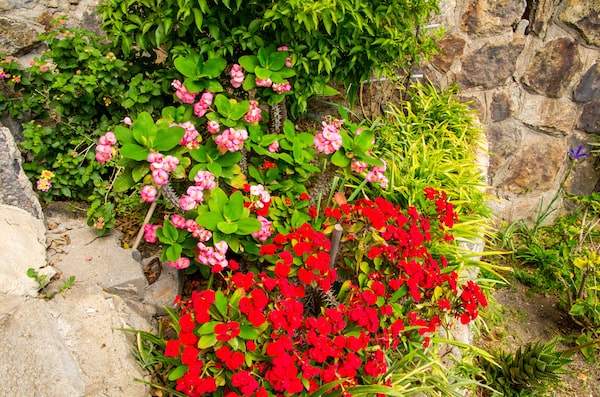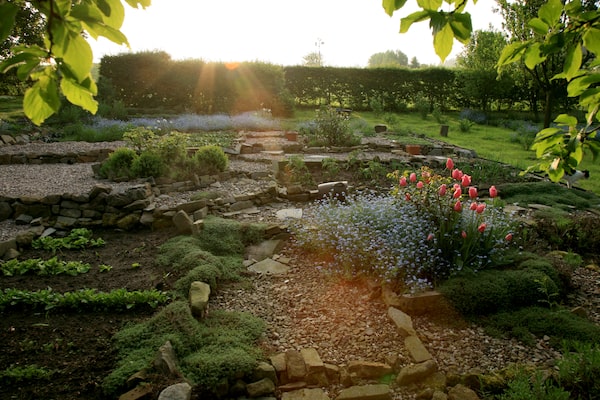Growing interest in plants among millennials – combined with aging boomers who want gardens that are more maintenance-free – means gardens today are often radical departures from traditional English or European country and estate gardens.
Now natural, native and sustainable gardens are being nurtured in more creative ways by professionals and amateurs, alike. “The younger generation is moving in and they want to do it their way,” Toronto-based veteran gardener Dugald Cameron says. The result is gardens that increasingly reflect the diversity of our landscape, as well as our population, and our indigenous plants. Boomers, for their part, want less back-breaking work.
“Our gardens are closer to nature than they’ve ever been,” Cameron says. “And if you think of gardening as an art form then what you like, or don’t like, all comes down to personal taste.”
Here, five non-traditional gardens to inspire your plotting for warmer weather.
Rock garden

Rock gardens require minimal upkeep and look great too.Aliaksandr Antanovich/iStockPhoto / Getty Images
With many gardeners short on weeding time, rockeries are having a revival. Using boulders to build rock gardens that require minimal upkeep, these spaces look great in real life and on Instagram, and are the ideal backdrop for a wide range of perennials. Plants that thrive include creeping thyme, Angelina stonecrop, spreading conifers, alpines, rockfoils (the Latin name Saxifraga means “stone breaker”), and hardy succulents such as hens and chicks, which survive outside in the ground year-round. Rock gardens want full sun and gravelly, well-drained soil.
Water garden

Wetland plants like blue flag iris, puzzlegrass, sweet flag and water lily are ideal for a pond garden.Eirasophie/iStockPhoto / Getty Images
The water garden has traditionally been just one of many different features in a garden, but with Canadian cities growing at exponential speed – and lot sizes shrinking – homeowners are turning to water gardens as the focal point for compact outdoor settings. They’re ideal for urban living because they provide white noise to drown out traffic and the plants attract wildlife. There are a multitude of wetland plants that are ideal including blue flag iris (Quebec’s provincial flower), puzzlegrass, sweet flag, and of course, the water lily. A perfect plant for water’s edge is the cardinal flower, which attracts hummingbirds.
Native plant garden

Native plants flourish anywhere, in rural or urban settings, and have the ability to attract birds, insects and other wildlife.fotokate/iStockPhoto / Getty Images
Just as the name implies, these gardens are comprised of plants indigenous to Canada. The main appeal is their unfettered look and ability to attract birds, bees, insects and other wildlife. Native plant gardens flourish anywhere, in rural or urban settings, and in tiny or large spaces. The key is to know soil and light conditions when choosing plants. Homegrown species are typically bee- and butterfly-friendly (these gardens are a boon to Canada’s endangered monarch butterfly population). Don’t be surprised to find plants that were once considered noxious weeds, such as milkweed and golden rod, suggested for this type of garden. Other additions can include the oakleaf hydrangea, switchgrass, and northern sea oats (which you have to keep on top of because it loves to reseed).
Vertical garden

A wall garden requires a strong support structure with the ability to withstand moisture.Iryna_L/iStockPhoto / Getty Images
If you can’t go out, go up. Ideal on sunny balconies or terraces, these gardens are the perfect antidote to looking at a blank, boring wall. A couple caveats, however. Don’t go too tall (difficult to maintain), make sure it’s sunny and that the support structure is strong and able to withstand moisture. Flowering plants include clematis, roses, Virginia creeper and climbing hydrangea. Vegetables that love to climb are squashes and beans.
Shrub garden

Gardeners often choose shrubs for winters as they're low-maintenance.Fotofantastika/iStockPhoto / Getty Images
The definition of a shrub, in gardening terms, is anything less than six meters The key to a beautiful shrub garden with year-round interest is getting the right mix of textures, colours and heights. In years past, shrubs were typically pruned back for a manicured look. Now they’re left more or less untamed. Cameron likes to mix evergreens with shrubs such as red bark twig dogwood, paperbark maple, dwarf conifers, mock orange lilac and star magnolia. People often choose shrub gardens for their winter interest and because they’re low-maintenance. “They are like a sculpture collection in a way,” he says. “They can be all shapes and sizes, and they are there all the time.”
Sign up for the weekly Style newsletter, your guide to fashion, beauty and design, and follow us on Instagram @globestyle.
 Gayle MacDonald
Gayle MacDonald